President class Frigates (1962)
 South African Navy (1959-64)
South African Navy (1959-64)
President Kruger, President Pretorius, President Steyn
President Class:
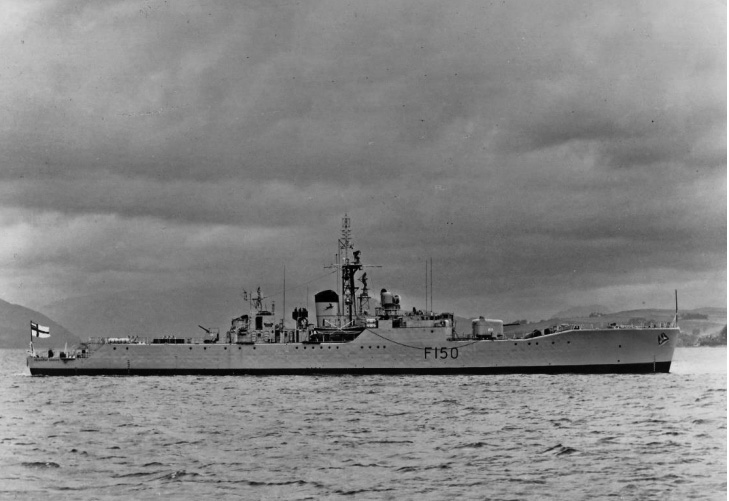
President Kruger (Courtesy of P.Dubois)
Under the 1955 Simon’s Town Agreement, the South African Navy had to purchase modern anti-submarine frigates, coastal minesweepers and defence boats from Britain as part of the agreement to defend the sea routs around Southern Africa. With the acquisition of the SAS Vrystaat (Type 15 frigate) in 1956, the South African government continued with its expansion program by placing an order at the British yards in 1957 for the construction of three new modified Type 12 anti-submarine frigates or Rothesay class frigates as they would subsequently be known as in British service.
Specifications development
The Type 12 was designed for high speed, manoeuvrability, and good seakeeping. In total twelve of the Rothesay class frigates were laid down for the Royal Navy with the addition of two Rothesay class frigates built for the New Zealand Navy, six for the Royal Australian Navy under the designation River class and three build for the South African Navy under the designation “President class”.
The first President class frigate, “SAS President Kruger”, was laid down on 6 April 1959 at the Clyde yard of Messrs Yarrow & Company, Scotstoun, and was launched 18 months later, on 20 October 1960. The new frigate had the distinction of being the first major war vessel ever built to the order of the South Africa Navy. The second vessel to be laid down was the “SAS President Steyn”, which was launched on 23 November 1961 at the Linthouse yard of Alexander Stephen & Son. After the launch of the SAS President Steyn, the third and final vessel was launched on 28 September 1962 at the Cydeside yard of Yarrow’s at Scotstoun and would receive the name “SAS President retorius”. The arrival of President class frigates brought a close to the South African Navy’s extensive expansion phase and formed part of 19 new vessels acquired from the United Kingdom as part of the Simon’s Town Agreement.
Design of the President class
Armaments & electronics
As an anti-submarine frigate, the frigate’s main role was to search and destroy submarines.
The President class would achieve this with the use of two three-barrel Limbo anti-submarine mortars situated aft of the vessel. The Limbo mortar could fire the Mk 6 projectiles at ranges up to 2000 yards and was automatically aimed and fired by the hull mounted Type 170 short-range search and attack sonar. The Type 170 sonar would also work in conjunction with Type 164 target classification sonar and the Type 177M panoramic search sonar, allowing the vessel to detect and destroy submarines at a greater range and with more accuracy.
The main armament onboard the President class consisted of a twin Vickers 4.5-inch Mk 6 dual-purpose turret fitted forward of the bridge and was remote controlled by a Mk 5 Flyplane Predictor System which incorporated both optical sights and the Type 275 gunnery radar. The twin 4.5-inch mounting could effectively engage both surface and air targets and was also ideally suited for shore bombardment. With a maximum range of 10 miles, these guns were very accurate and could fire up to twenty rounds per minute per barrel. Further aft on the vessel a twin Mk V Bofors with its associated Type 262 radar was fitted to provide close range defence against aircraft.
Working in conjunction with the main armament onboard the vessel was the Mk 6M gunfire director which is used for calculating range and elevation for the main guns against moving targets. In order to locate potential target, the vessel was equipped with the Type 293Q combined air and surface radar, the Type 978 navigation radar and the Type 277Q height-finder. The vessel also carried HF/DF and UA3 electronic countermeasures, as well an Identification Friend or Foe Mk X antenna.
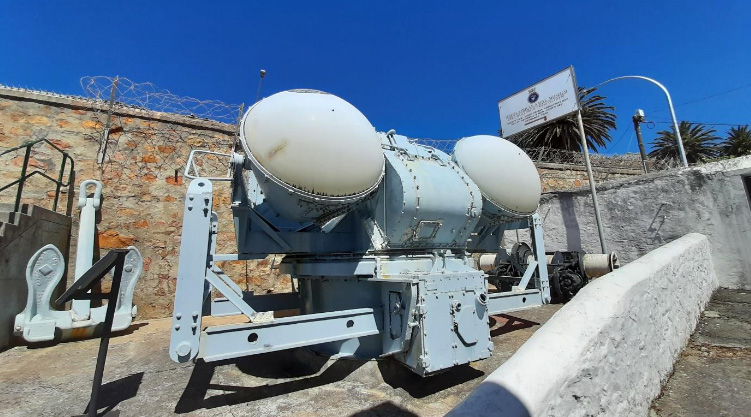
Mk 6M Gunfire Director at the SA Naval Museum (R.Ackerman)
Powerplant
When it comes to performance, the President class was fitted with two high power turbine plants using double reduction gearing to achieve low revolutions and maximum efficiency at high power. These two turbines produced at total of 30 430 horsepower and drove two shafts fitted with five bladed propellers which would allow for a top speed of 30 knots. With the correct weather and sea condition the President class could travel a total of 4 500
nautical miles.
Manoeuvrability of the vessel was very good due to the adaptation of twin rudders and the hull form, which was kept reasonably fine to assist in achieving high speeds. The vessel also featured a high freeboard and flared bow with a prominent half-raised forecastle to achieve lift forward. An all-welded hull was chosen for the vessel in order to achieve both lightness and strength and was partly prefabricated to enable rapid production.
Living conditions
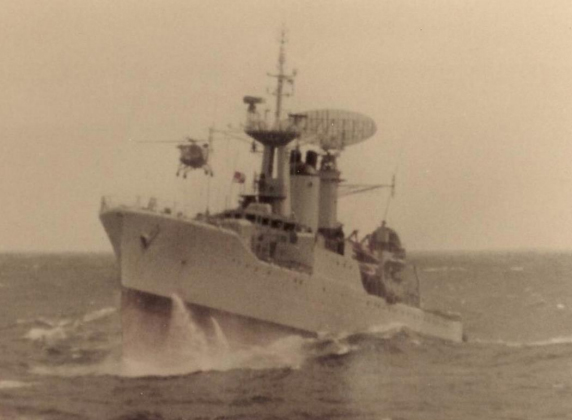
SAS President Pretorius conducting Wasp helicopter recovery (Cameron Kirk Kinnear)
The President class became popular among the crew due to the habitability of the vessel being of high standards, especially when compared to earlier frigates. The vessel made provision for a cafeteria system, centralised gally system and well-appointed dining halls for the crew. The crew living accommodation was well illuminated by florescent lighting, each bunk had its own reading lamp and amenity points. A full air-conditioning system with a preset temperature was also installed to improve working conditions onboard the vessel.
It is also worth noting the President class was designed to operate under nuclear fallout conditions and were built in such a manner that all living and operational spaces could be sealed off from the atmosphere. To prevent contamination from settling, a pre-wetting system was installed, which when turned on enveloped the entire ship in an affective salt-water haze and would wash overboard radioactive particles that might have settled.
Rothesay vs President classes
The South African President class was different from the Rothesay class in that no provision was made for the Seacat system (British short-range surface-to-air missile) and instead shipped a twin Bofors Mk V with its associated Type 262 radar. The President class was also fitted with a later and more capable Type 177M hull-mounted panoramic search sonar in place of the Type 174 which is usually fitted to the Rothesay Class. In addition, a non-retractable fin stabiliser was equipped on the President class to provide a more stable platform for the ship fitted weapons and sensors due to the notorious Cape waters in which the vessels would have to operate in.

President Kruger after modernization (conways)
⚙ Specifications: President class as completed |
|
| Displacement: | 2 170 tons standard, 2 605 tons FL |
| Dimensions: | 112,78 oa x 12,5 x 5,331m ( feets) |
| Propulsion: | -Two sets of English Electric double reduction geared turbines -Two Turbo alternators -Two 12-cyl Paxman Diesel generators -Two Babcock and Wilcox controlled superheat type. |
| Output: | 30,430 shp |
| Speed: | 30 knots ( km/h; mph) |
| Range: | 4,500 nmi ( km) at 12 knots cruise speed |
| Armament: | 1x twin Vickers 144mm Mk6 Mod 1 Dual purpose mounting 1x twin 40/60 Bofors Mk5 AA 2×3 ASWRL Mk10 (Limbo, triple-barrelled) anti-submarine rockets |
| Electronics: | (Based on Rothesay): Radar type 975, 977, 293, 262, 1994, 1978. Sonar 170, 174/177, 162. |
| Crew: | 214 |
Career of the President class
All three President Class frigates formed part of the 10th Frigate Squadron and would conduct regular coastal patrols as well as participate in numerus naval exercises with the Royal Navy and other friendly navies as they rounded the Cape. The frigates also deterred territorial violations around South Africa and Southwest Africa and were also often called upon to assist those in distress in the surrounding waters of South Africa and to make mercy
dashes to outlying islands in the South Atlantic.
The first of these dashes occurred on 29 June 1966 when a message reached Cape Town by radio, from the South African weather station on Marion Island, communicating that the radio transmitting room and virtually all living accommodation had been destroyed by a fire. As a result, SAS President Kruger under command of Captain D K Kinkead-Weekes, which was on passage to Durban in company with SAS President Pretorius, was dispatched to the
island to render aid.
Besides patrolling local waters, the frigates was also frequently used to foster good relations with friendly countries. In November 1967 a South African Naval squadron consisting of the SAS President Kruger, SAS President Steyn and the replenishment vessel SAS Tafelberg, crossed the South Atlantic and paid a memorable visit to Argentine. Under the command of Commodore J Johnson, the squadron visited Puerto Belgrano and Buenos Aires, and exercised with the Argentine Navy destroyer squadron during the deployment.
A year later in 1968 the SAS President Pretorius, SAS President Steyn and the replenishment vessel SAS Tafelberg, would cross the Southern Ocean again under the command of Commodore J Johnson. On this occasion to visit Australia, the first since SAS Transvaal’s historic visit 17 years previously. As many South Africans and Australian officers worked and trained together during World War 2, the opportunity to meet the Royal Australian Navy at
home was welcomed.
During late January 1971 SAS President Kruger under the command of G N Green, had the privilege to escort South Africa’s first submarine, the SAS Maria van Riebeeck from Toulon in France. The SAS President Kruger had a particularly interesting cruise, making stop at a number of ports throughout the journey, including Luanda, Las Palmas, Lisbon, Naples, Augusta, Toulon, Gibraltar and Sao Vincente. On the return journey from Europe SAS
President Kruger assisted in towing the broken-down tanker Simfonia clear of “Danger Point” on 24 June. The vessel also acted as a guard ship for the Lipton Cup Sailing regatta held off Durban in July at the end of the return journey.
Modernisation program
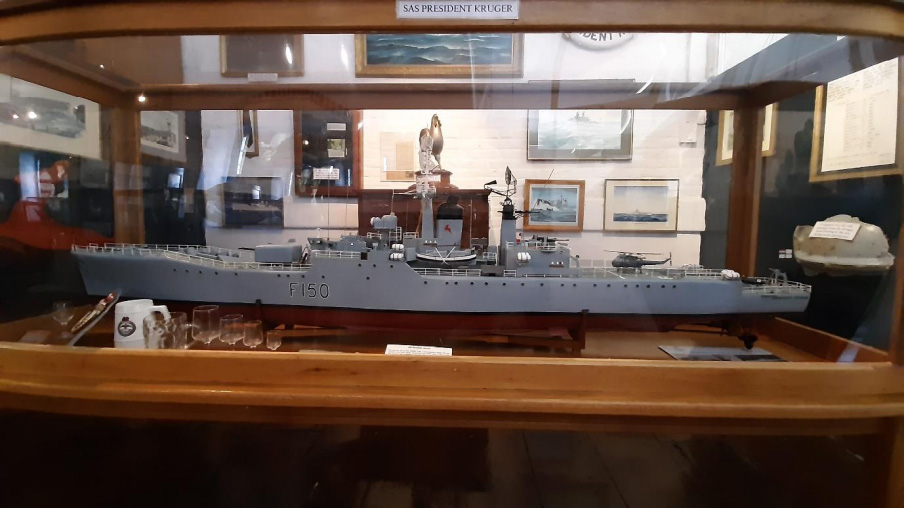
Model of SAS President Kruger at the SA Naval Museum (R.Ackerman)
During 1967 the South African Navy commenced a modernisation program for its three President class frigates which were to be the most complex modernisation ever undertaken by the South African Naval Dockyard in Simons town. The first ship taken for modernisation was the SAS President Kruger on 29 January 1968, followed by the SAS President Steyn on 5 August 1969 and finally the SAS President Pretorius on 11 May 1971.
The conversion involved the removal of the forward Limbo anti-submarine mortar together with the twin 40mm guns, in order to install a flight deck and fully equipped hanger for the Wasp helicopter. The Westland Wasp helicopter onboard the President class frigates was used for anti-submarine warfare and could carry a Mk 44 torpedo or Mk 11 depth-charges.
A new fully enclosed mainmast was also constructed atop the forward part of the helicopter hanger to support a Thompson CSF Jupiter Long-range air-warning radar. The mainmast onboard President Pretorius received further improvement, being more streamlined and the size significantly reduced as a result of boiler smoke and fume dispersal problems experienced onboard the President Kruger and President Steyn. It is also for this reason the President Pretorius received a remodelled Leander type funnel which significantly changed her silhouette. The smoke and fume dispersal problem on her sister ships (President Kruger & Steyn) was eased by lengthening the funnel and extending the uptakes.
The boilers onboard President Kruger and President Steyn remained the same and continued to burn oil fuel while President Pretorius were converted to run on diesel fuel as well as her ballast tanks being converted to self-compensating fuel tanks.
Although the President Kruger kept the original Mk 6M gunfire director, gyro rate unit stabiliser and below-control unit, her sister ships (President Steyn & Pretorius) were fitted with a more modern Selenia Orion Gunfire Control System. The President Pretorius was also fitted with a modern optical director aft of the bridge. With the removal of twin Bofors Mk V anti-aircraft mounting, two single 40mm Bofors anti-aircraft guns were mounted on the
hanger roof, provision was also made to equip the vessel with four 12,7mm Browning machine guns.
Other improvements included the addition of two triple barrelled Mk32 torpedo tubes amidship for firing Mk 44 anti-submarine homing torpedoes, and the provision for electronic countermeasures & support equipment. A large winch was also installed for towing the Type 182 decoy, which seduces submarine-launched homing torpedoes fired at the ship. During the early 1980s President Pretorius received additional modifications, notably to the quarterdeck to enable her to lay mines and to transport new assault boats in place of the original whaler and 25-foot motor cutter.
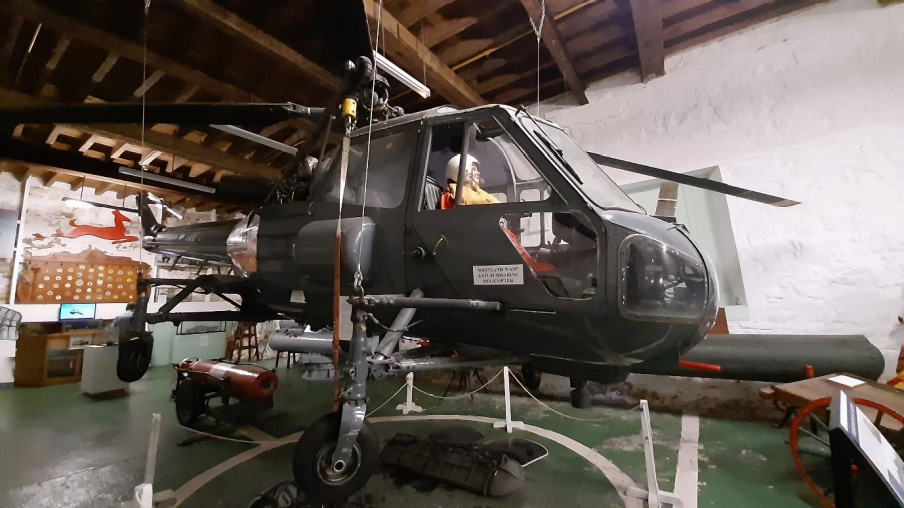
Westland Wasp Helicopter at the SA Naval Museum (R.Ackerman)
⚙ Specifications: President class (as converted) |
|
| Displacement: | 2 380 tons standard, 2 800 tons FL |
| Armament: | 1x twin Vickers 144mm Mk6 Mod 1 Dual purpose mounting 2x 40mm/60 Bofors Mk9 AA, 4x 12,7mm HMGs (single mounts) 2×3 ASWRL Mk10 Limbo |
| Onboard aviation: | Westland Wasp HAS Mk1 with Mk44 torpedoes/Mk11 Depth Charges |
| Electronics: | See notes, Radar type 903 |
| Crew: | 236 |
The President Class at war
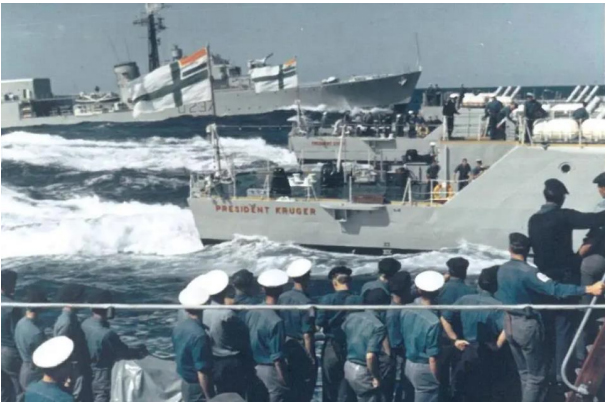
All three President class frigates together with destroyer SAS Simon van der Stel in close formation (SA Naval Museum)
Between October 1975 and January 1976, two of the President class frigates, SAS President Kruger and SAS President Steyn, supported by the SAS Tafelberg (replenishment vessel) took part in Operation Savannah, the South African incursion into Angola. The frigates were tasked to patrol the Angola coast and prevent possible enemy landings, be available to evacuate South Africa Defence Force (SADF) personnel from Angola, provide naval gunfire
support if required and escort supply ships to the southern Angolan port of Lobito.
Under the command of Captain R D Kingon, SAS President Kruger Sailed from Cape Town on 5 November 1975 for Walvis Bay from where she sailed northwards under strict radar and radio silence due to the presence of Soviet vessels in the area. After three weeks SAS President Kruger was relieved by SAS President Steyn under the command of Captain A S Davis which had originally been scheduled for an operational visit to the Indian Ocean Island
of Reunion between 24 and 28 November 1975.
SAS President Steyn was involved in a particular daring mission when she rescued Brigadier Ben Roos, South Africa’s chief adviser to the FNLA (National Liberation Front of Angola), together with 25 other South Africans, off a beach near Luanda in pitch darkness after the collapse of the FNLA’s offensive in the north. Holden Roberto, leader of the FNLA had decided to advance and capture Luanda, a stronghold of the rival MPLA (People’s
Movement for the Liberation of Angola). Brigadier Roos strongly advised against committing all the FNLA troops to a narrow road flanked by swamps in the final assault on Luanda.
Roberto persisted and suffered a crushing defeat which led to the end of the FNLA participation in the civil war. Since the MPLA controlled most of the territory, it was decided the best way to withdraw them would be by sea. The pick-up by SAS President Steyn at Ambritzete, north of Luanda was set for 23:00 on 27 November. However, the road to Ambrizete was bad and it was not until 04:00 the following morning that Brigadier Roos and his men finally reached the pickup point and were able to signal the frigate. In the meantime, SAS President Steyn had cautiously navigated the coast in total darkness under radar silence, only using the echosounder for navigation.
Eventually vehicle lights would be sighted ashore at 04:24 and contact was made with Brigadier Roos a short while later. Three rubber zodiac boats under the command of Lieutenant R L N Erleigh, had been sent to the beach, assisted by a motor cutter and the frigate’s Wasp helicopter flown in daunting conditions by Captain Ben van der Westhuizen from the South African Air Force (SAAF). By 06:50, the daring operation was complete, and the frigate slipped away bound for Walvis Bay where she landed Brigadier Roos and his men before returning to the patrol area of the Angola coast, where the frigate remained until well into January 1976.
The loss of a President Class

Impact force between SAS President Kruger and SAS Tafelberg (R.Ackerman)
During the early hours of 18 February 1982, the South African Navy was dealt a devasting blow when the SAS President Kruger was lost in the South Atlantic following a collision with the fleet replenishment vessel SAS Tafelberg. At the time of the collision, the SAS President Kruger together with SAS President Pretorius were engaged in an exercise, protecting the SAS Tafelberg from the submarine SAS Emily Hobhouse.
The accident occurred while SAS President Kruger was executing a screen-reorientation manoeuvre in heavy seas with strong winds. SAS President Kruger turned inwards towards the SAS Tafelberg and crossed the replenishment ship’s bows, in an attempt to avert a close quarters situation, the vessel unexpectedly crossed the SAS Tafelberg bows a second time, which resulted in the two ships colliding.
The collision occurred at 03:51, as the SAS Tafelberg struck the SAS President Kruger, penetrating the port quarter of the vessel, aft of the hanger. A huge hole was torn into the side of the frigate. The two ships remained attached for about 30 seconds and then parted, with SAS President Kruger’s stern section dragging along the port side of the SAS Tafelberg. Of the 15-crew sleeping in Mess number 12 at the time of the collision, only two men
escaped death as the SAS Tafelberg sliced into the frigate and tons of water flooding the mess together with fuel oil from the ruptured tank.
Distress signals were immediately sent out following the disaster, with the SAS President Kruger signalling the SAS President Pretorius, that she had collided with the SAS Tafelberg and was sinking. The SAS President Kruger’s commander, Captain W J de Lange inspected the holed and heavily listing vessel and decided the risk of saving her was too great and gave the order to abandon ship at 04:36. The SAS President Kruger finally disappeared from her
sister’s radar screen at 05:29 and plummeted 3000 meters to the ocean floor.
SAS President Pretorius immediately commenced rescue operations and by 05:55, 30 oil-covered survivors had been rescued from the rough seas. The SAS President Pretorius was soon joined by the SAS Tafelberg and SAS Emily Hobhouse, whilst a SAAF Shackleton and two Super Frelon helicopters arrived at the scene and joined the search for survivors at 06:00. A number of civilian and naval vessels from both Cape Town and Simon’s Town also reached the area during the course of the day and continued the search for survivors throughout the night.
Of the 193 men onboard the frigate at the time of the collision, 67 were rescued by the SAS Tafelberg and 110 by the SAS President Pretorius, by 13:00. This would end up being one ofthe most dramatic days in South African Naval history since World War Two. In total 16 members lost their lives in the disaster, and despite an extensive search which continued until sunset on 21 February, only one body was ever recovered.
Life extension proposal
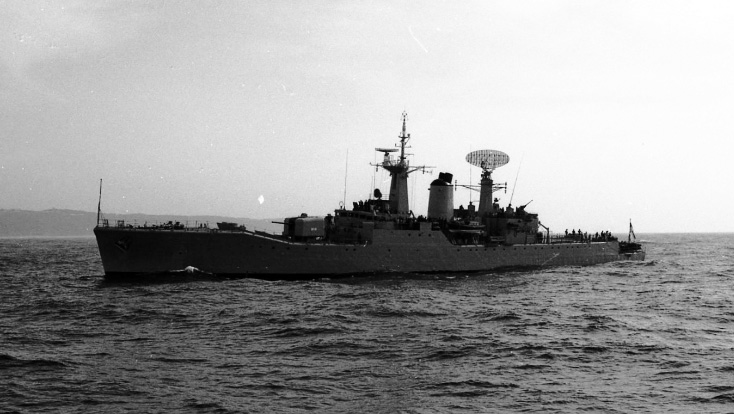
SAS President Pretorius post conversion (SA Naval Museum)
In order to keep the two remaining President class frigates operational, a new modernisation plan was proposed which involved stripping the vessels down to their bare hulls, rebuilding them and incorporating the latest in weapons and sensor development. The plan made provision for replacing the steam turbines and boilers with a diesel propulsion arrangement, extending the bridge deck to provide a larger flight deck for two Puma helicopters, and the complete reconstruction of the superstructure, mast, and funnel.
Planned armaments for the vessels included two single 76mm guns in superimposed position forward of the new bridge structure. In addition, Skerpioen (Afrikaans for Scorpion) surface-to -surface missile launchers were planned to be installed with close-in weapons and triple barrelled Mk 32 torpedo tubes.
Modernisation plans for the President class frigates would sadly not become a reality due to a lack of funding, ultimately leading to the frigates being decommissioned in the early 1990s. The decommissioning of the final President class meant the end of a proud era for the graceful President class frigates which were at the forefront of the South African Navy for more than three decades and would end up forming an important part of South African
naval history.
Read More/Src
Toit, A. D., 1992. President class. In: South Africa’s Fighting Ships Past and Present. Johannesburg: Ashanti Pubilshing , pp. 220-239
Museum, S. A. N., 2020. Facebook. [Online] [Accessed 22 February 2022]
On sanavymuseum.co.za
Steyn, L., 2016. Facebook. [Online]
Bennett, C., n.d. The loss of SAS President Kruger. [Online]
On defenceweb.co.za
[Accessed 14 March 2022].
Dickens, P., n.d. “Out of the Storm came Courage” … the tragedy of the PK. [Online]
Available at: samilhistory.com
[Accessed 14 March 2022].
Toit, A. D., 1992. President class. In: South Africa’s Fighting Ships Past and Present. Johannesburg: Ashanti Pubilshing , pp. 220-239


 Latest Facebook Entry -
Latest Facebook Entry -  X(Tweeter) Naval Encyclopedia's deck archive
X(Tweeter) Naval Encyclopedia's deck archive Instagram (@navalencyc)
Instagram (@navalencyc)





 French Navy
French Navy Royal Navy
Royal Navy Russian Navy
Russian Navy Armada Espanola
Armada Espanola Austrian Navy
Austrian Navy K.u.K. Kriegsmarine
K.u.K. Kriegsmarine Dansk Marine
Dansk Marine Nautiko Hellenon
Nautiko Hellenon Koninklije Marine 1870
Koninklije Marine 1870 Marinha do Brasil
Marinha do Brasil Osmanlı Donanması
Osmanlı Donanması Marina Do Peru
Marina Do Peru Marinha do Portugal
Marinha do Portugal Regia Marina 1870
Regia Marina 1870 Nihhon Kaigun 1870
Nihhon Kaigun 1870 Preußische Marine 1870
Preußische Marine 1870 Russkiy Flot 1870
Russkiy Flot 1870 Svenska marinen
Svenska marinen Søværnet
Søværnet Union Navy
Union Navy Confederate Navy
Confederate Navy Armada de Argentina
Armada de Argentina Imperial Chinese Navy
Imperial Chinese Navy Marinha do Portugal
Marinha do Portugal Mexico
Mexico Kaiserliche Marine
Kaiserliche Marine 1898 US Navy
1898 US Navy Sovietskiy Flot
Sovietskiy Flot Royal Canadian Navy
Royal Canadian Navy Royal Australian Navy
Royal Australian Navy RNZN Fleet
RNZN Fleet Chinese Navy 1937
Chinese Navy 1937 Kriegsmarine
Kriegsmarine Chilean Navy
Chilean Navy Danish Navy
Danish Navy Finnish Navy
Finnish Navy Hellenic Navy
Hellenic Navy Polish Navy
Polish Navy Romanian Navy
Romanian Navy Turkish Navy
Turkish Navy Royal Yugoslav Navy
Royal Yugoslav Navy Royal Thai Navy
Royal Thai Navy Minor Navies
Minor Navies Albania
Albania Austria
Austria Belgium
Belgium Columbia
Columbia Costa Rica
Costa Rica Cuba
Cuba Czechoslovakia
Czechoslovakia Dominican Republic
Dominican Republic Haiti
Haiti Hungary
Hungary Honduras
Honduras Estonia
Estonia Iceland
Iceland Eire
Eire Equador
Equador Iran
Iran Iraq
Iraq Latvia
Latvia Liberia
Liberia Lithuania
Lithuania Mandchukuo
Mandchukuo Morocco
Morocco Nicaragua
Nicaragua Persia
Persia San Salvador
San Salvador Sarawak
Sarawak Uruguay
Uruguay Venezuela
Venezuela Zanzibar
Zanzibar Warsaw Pact Navies
Warsaw Pact Navies Bulgaria
Bulgaria Hungary
Hungary

 Bundesmarine
Bundesmarine Dutch Navy
Dutch Navy Hellenic Navy
Hellenic Navy Marina Militare
Marina Militare Yugoslav Navy
Yugoslav Navy Chinese Navy
Chinese Navy Indian Navy
Indian Navy Indonesian Navy
Indonesian Navy JMSDF
JMSDF North Korean Navy
North Korean Navy Pakistani Navy
Pakistani Navy Philippines Navy
Philippines Navy ROKN
ROKN Rep. of Singapore Navy
Rep. of Singapore Navy Taiwanese Navy
Taiwanese Navy IDF Navy
IDF Navy Saudi Navy
Saudi Navy Royal New Zealand Navy
Royal New Zealand Navy Egyptian Navy
Egyptian Navy South African Navy
South African Navy






























 Ukrainian Navy
Ukrainian Navy dbodesign
dbodesign
The frigates that went to Argentina in 1967 were President Kruger and President Pretorius, NOT President Steyn. I was part of the crew on the Pretorius as a diver and worked as a watch keeper in the bridge. Before and during the Argentina trip the Steyn was undergoing sea trials and commissioned upon the return of the two frigates. The Kruger was decommissioned as part of the rotation system. .